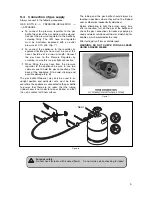
5
Figure 3.
Figure 2.
3. Cleaning
Clean both the inside and outside of the
appliance before putting it into use.
To do so, use a soft towel, lukewarm water and a
non-abrasive detergent. Ensure water does not
enter the rear cover grill or the control panel.
Afterwards, wipe the appliance with a clean towel
and cleanwater, and then wipe it dry.
To avoid damage, do not use soap, soda or
abrasive cleaners.
4. Positioning the appliance
During the refrigeration process, the appliance
gives off heat from the condenser (under the
upper part of the rear cover) into the surrounding air.
The more ventilated the condenser is, the more
effective the refrigeration will be.
Good ventilation is important for the optimum
performance of the refrigerator and it must never be
placed closer than 10cm (4") away from the wall nor
installed in a closed niche. The ventilation slots on
the rear panel and the exhaust slots on the top must
not be blocked.
Warning: Do not place anything
on top of the exhaust slots
(Figure 2)
.
For maximum performance the appliance must be
level at all times when operating. If the appliance is
operating in a moving vehicle, the amount of the
refrigeration will be slightly less than if the appliance
is level in a stationary position.This is caused by the
movement of the vehicle impairing the flow of the
refrigerant within the unit.
It is important that the appliance is not directly
exposed to radiated heat (sunlight, radiator, near an
oven, etc.).
5. Using the appliance
The cable for 240 Volt mains connection, the 12V
connection and the gas inlet are located on the rear
cover of the cooling box (Figure 3).
5.1. Operating from 240 Volt
electrical mains
Before using your refrigerator box, please check
whether the mains-voltage at your home or at the
camp-site is the same as that specified on the rating-
plate.
The rating-plate is located on the back of all modells.
Your refrigerator is fitted with a regular earthed plug for
connection to a regular earthed socket (please use an
adaptor when abroad).
Now turn the thermostat control (A) to maximum
cooling i.e. in a clockwise direction as far as the stop.
When a sufficient low temperature has been reached,
the thermostat control (A) can be turned back again to
obtain the degree of cooling desired.
Summary of Contents for RC 1600 EGP
Page 11: ...11...






























